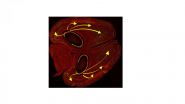(Press-News.org) Focusing on large, star-forming galaxies, researchers at the Johns Hopkins University were able to measure radiation leaks in an effort to better understand how the universe evolved as the first stars were formed.
Sanchayeeta Borthakur, an assistant research scientist in the Department of Physics and Astronomy in the university's Krieger School of Arts and Sciences, reports in a paper published online Oct. 9 in the journal Science that an indicator used for studying star-forming galaxies that leak radiation is an effective measurement tool for other scientists to use.
Borthakur wrote the paper with Timothy Heckman, the Dr. A. Hermann Pfund Professor and director of the Center for Astrophysical Sciences at Johns Hopkins, along with co-authors Claus Leitherer from the Space Telescope Science Institute and Roderik Overzier from the Observatorio Nacional in Rio de Janeiro, Brazil.
The researchers used the radiation leak measurement method to help find the ideal star-forming galaxy that contained holes in its cold gas cover. Studying the radiation that seeps through these holes has been a conundrum for scientists for years.
Consisting of thick, dense cold gas, the cover stretches across a galaxy like a blanket. While an effective tool for helping make stars, this cover presents a challenge for astrophysicists hoping to learn how the radiation that stars produce could be used in the ionization process. Scientists have been on a quest for decades to find just the right galaxy with this character trait.
"It's like the ozone layer, but in reverse," Borthakur said. "The ozone layer protects us from the sun's radiation but we want the gas cover the other way around. The star forming regions in galaxies are covered with cold gases so the radiation cannot come out. If we can find out how the radiation gets out of the galaxy, we can learn what mechanisms ionized the universe."
Borthakur said scientists know that these leaky galaxies exist, but finding one has been a problem. This, in turn, makes it difficult for researchers to have a clearer understanding of how the reionization process works.
For star-gazers, reionization is core to the history of the cosmos as it marks the birth of the very first stars and galaxies.
Moments after the start of the Big Bang, the hot, newly born universe began to expand and quickly cool. Several hundred thousand years later, free proton and electron particles in the universe began to connect to each other and form neutral hydrogen atoms. The neutral gas began to collapse into the first stars and galaxies, which then began to radiate brightly.
Using observations made with the Cosmic Origin Spectrograph onboard the Hubble Space Telescope, the research team found the right galaxy to study. In the study, the researchers credit a combination of unusually strong winds, intense radiation and a massive, highly star-forming galaxy for proving the validity of the indicator.
This method, first created by Heckman in 2001, can sort out what gas is present and also accurately measure the percentage of holes in the gas cover, said Borthakur.
"The confirmation of the indicator is key," she said. "The implications are now people can use this indicator to study distant galaxies at longer wavelengths."
INFORMATION:
This research was funded by NASA with grant number 12886.
Leaky galaxies lead researchers to better understand the universe
2014-10-10
ELSE PRESS RELEASES FROM THIS DATE:
Hormone loss could be involved in colon cancer
2014-10-10
(PHILADELPHIA) – Some cancers, like breast and prostate cancer, are driven by hormones such as estrogen and testosterone, but to date, there are none that are driven by the lack of a hormone. New evidence suggests that human colon cells may become cancerous when they lose the ability to produce a hormone that helps the cells maintain normal biology. If verified by further studies, it suggests that treating patients at high risk for colon cancer by replacing the hormone guanylin could prevent the development of cancer.
The researchers at Thomas Jefferson University ...
Elevated cholesterol and triglycerides may increase the risk for prostate cancer recurrence
2014-10-10
PHILADELPHIA — Higher levels of total cholesterol and triglycerides, two types of fat, in the blood of men who underwent surgery for prostate cancer, were associated with increased risk for disease recurrence, according to a study published in Cancer Epidemiology, Biomarkers & Prevention, a journal of the American Association for Cancer Research.
"While laboratory studies support an important role for cholesterol in prostate cancer, population-based evidence linking cholesterol and prostate cancer is mixed," said Emma Allott, PhD, postdoctoral associate at Duke ...
In-home visits reduce drug use, depression in pregnant teens
2014-10-10
Intensive parenting and health education provided in homes of pregnant American Indian teens reduced the mothers' illegal drug use, depression and behavior problems, and set their young children on track to meet behavioral and emotional milestones they may have otherwise missed.
The Johns Hopkins Bloomberg School of Public Health-led research also suggests that employing local community health educators instead of more formally educated nurses to counsel young at-risk mothers could be cost effective and provide badly needed jobs to high school graduates from the same ...
Bowel cancer risk reduced by adopting multiple healthy behaviors
2014-10-10
Adoption of a combination of five key healthy behaviors is associated with a reduction in the risk of developing bowel cancer. Researchers from the German Institute of Human Nutrition Potsdam-Rehbruecke quantified the impact of combined multiple healthy lifestyle behaviors on the risk of developing bowel cancer, and found that this impact is stronger in men than in women.
Lead author, Krasimira Aleksandrova, says: "These data provide additional incentive to individuals, medical professionals and public health authorities to invest in healthy lifestyle initiatives. Each ...
The Lancet Global Health: Widely used sanitation programmes do not necessarily improve health
2014-10-10
The sanitation intervention delivered under the terms of the Government of India's Total Sanitation Campaign—the world's largest sanitation initiative—provided almost 25 000 individuals in rural India with access to a latrine. However, it did not reduce exposure to faecal pathogens or decrease the occurrence of diarrhoea, parasitic worm infections, or child malnutrition.
"The programme is effective in building latrines, but not all households participate"*, explains lead author Professor Thomas Clasen from Emory University, Atlanta, USA and the London School ...
Recent kidney policy changes have not created racial disparities in care
2014-10-10
Washington, DC (October 9, 2014) — Recent policy and guideline changes related to the care of patients with kidney failure have not created racial disparities, according to a study appearing in an upcoming issue of the Journal of the American Society of Nephrology (JASN). Such studies are needed to ensure that all patients continue to receive the highest quality of care after such changes are implemented.
In 2011, the End-Stage Renal Disease Prospective Payment System went into effect, which changed the way dialysis facilities were paid for care related to kidney ...
Electrically conductive plastics promising for batteries, solar cells
2014-10-10
WEST LAFAYETTE, Ind. – An emerging class of electrically conductive plastics called "radical polymers" may bring low-cost, transparent solar cells, flexible and lightweight batteries and ultrathin antistatic coatings for consumer electronics and aircraft.
Researchers have established the solid-state electrical properties of one such polymer, called PTMA, which is about 10 times more electrically conductive than common semiconducting polymers.
"It's a polymer glass that conducts charge, which seems like a contradiction because glasses are usually insulators," said ...
Migrating animals' pee affects ocean chemistry
2014-10-09
The largest migration on the planet is the movement of small animals from the surface of the open ocean, where they feed on plants under cover of darkness, to the sunless depths where they hide from predators during the day.
University of Washington researchers have found that this regular migration helps shape our oceans. During the daylight hours below the surface the animals release ammonia, the equivalent of our urine, that turns out to play a significant role in marine chemistry, particularly in low-oxygen zones. Results are published online this week in the Proceedings ...
Penn Medicine's 'sepsis sniffer' generates faster sepsis care and suggests reduced mortality
2014-10-09
PHILADELPHIA - An automated early warning and response system for sepsis developed by Penn Medicine experts has resulted in a marked increase in sepsis identification and care, transfer to the ICU, and an indication of fewer deaths due to sepsis. A study assessing the tool is published online in the Journal of Hospital Medicine.
Sepsis is a potentially life-threatening complication of an infection; it can severely impair the body's organs, causing them to fail. There are as many as three million cases of severe sepsis and 750,000 resulting deaths in the United States ...
Manipulating memory with light
2014-10-09
Just look into the light: not quite, but researchers at the UC Davis Center for Neuroscience and Department of Psychology have used light to erase specific memories in mice, and proved a basic theory of how different parts of the brain work together to retrieve episodic memories.
Optogenetics, pioneered by Karl Diesseroth at Stanford University, is a new technique for manipulating and studying nerve cells using light. The techniques of optogenetics are rapidly becoming the standard method for investigating brain function.
Kazumasa Tanaka, Brian Wiltgen and colleagues ...


